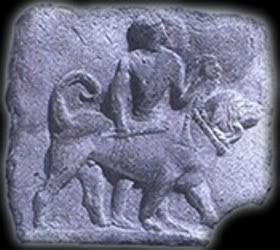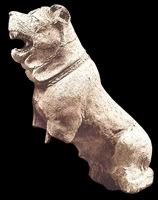Starrsdcct Neapolitan Mastiff Health Forum
Welcome to our forum. Feel free to ask questions or post a message.
This is The Neapolitan Mastiff (Mastino Napoletano)By Douglas Oliff....
In the Assyrian section of the British Museum is the Nineveh bas-relief, sculpted about 850 BC, which is in a remarkable state of preservation. The animal portrayed is a long-backed, heavy-fronted, massive dog, with a thick neck, being led on a double rope by a handler whom the dog certainly dwarfs. The head shows a short truncated muzzle, folds of skin on the cheeks and a pronounced dewlap. The tail is curled up over the back which may or may not be artistic licence. Those familiar with the Neapolitan Mastiff today will recognize the long stride of the foreleg, which is typical, and can be seen in the best contemporary specimens.
Early History....
Did such dogs exist over two thousand years ago? We can prove very little. It is possible that the sculptor just imagined that such a dog existed. however, there is such realism in the animal, and such presence and power, that it seems more likely to be from life rather than imagination. What was this ancient giant dog of the Middle East, and what were its origins? It is known that the Greeks and, Later, The Romans, admired the ferocious Mastiff-type dogs which were not uncommon in the Middle East. It seems that the word Molossus was used in Roman times to describe any large, formidable guard dog, and such animals were kept in the grand Roman houses for that purpose. One writer has suggested that the dogs were also kept in the Roman temples where "They could distinguish the pious from the idlers, and the Romans from the barbarians". This, I think, is colorful imagery but cannot be seriously considered.
In the fourth century BC, there was a Greek state called Epirus,close to Corfu. The rulers called themselves 'Molossians' and Alexander the Great's Mother was of this dynasty. History suggests that when Epirus was overrun by the Roman forces, among the plunder were dogs whose great size and physical power made them worthy imports to Rome for fighting in the arena. We have no proof that this took place, but we know that the Romans had an infallible eye for the appropriation of anything which would add to their glory. As the arena was one of the great pastimes, a superior, or a larger, fighting dog which existed in a conquered country would have been exported to Rome. What is possible of historical significance is that some of the Greek encyclopedias,as recently as the turn of the 20th century, listed among the dog breeds the 'Molossian of Epirus'.
What we can safely assume is that before the second World War a large, heavy guard dog existed in Italy, more especially in the region of Naples. It was used as a guardian of some of the grand estates, but also was owned by traders and other members of society. These dogs were more of a type, not a breed, but were generally known as 'Molossian', a term which covered many dogs with guarding abilities and a large size.As with the Mastiff in Britain,I have no doubt that the 'Molosser' group contained butchers' dogs, fighting dogs, guard dogs - in fact, any large dog of spirit.
After the war these dogs, which had been owned by a minority pre-war, had become so numerically weak that they were considered by many to be extinct. It should be realized that, even pre-war, the gene pool available to these dogs in a pure form was extremely limited, and the resultant inbreeding probably carried genetically inherited defects, which would have added to the parlous position in which the breed found itself.
Reconstruction
In 1946 a small nucleus of enthusiasts began to collect data about any living 'Molossians',hoping to establish the breed's existence in a recognizable form. A few animals of vastly differing types and degrees of soundness were located. Their one common feature was something of the spirit of the pre-war dogs. This rather heterogeneous collection was exhibited at the 1946 dog show in Naples, but their impact was not sensational. It was at this show that Piero Scanziani, a dog fancier and journalist living in Naples,was inspired to fight for the cause of the 'Molossian' and try to save from extinction a breed which was so much a part of the Italian heritage.
Scanziani must have realized that to find the breed in a pure form was unlikely, but he knew Naples and the surrounding countryside well, and believed that, with careful selection, it should be possible to reconstruct the old breed, even from such specimens as had already been located. He managed to find three dogs, a male and two females from which to start a reconstruction.
In 1949 he exhibited Guaglione at Naples, and created a sensation in the Italian dog press and dog-owning public. The dog went on to become the first Champion of the breed-but under what breed name? From the old generic term 'Molossian',the Neapolitan Mastiff or, in its country of origin, Il Mastino Napoletano. Although the name was new, the forebears of the breed were as Italian as the Bay of Naples. the threat of extinction had receded.
To re-establish a breed is not an easy task. It is doubtful if any pedigree records existed in an official form, and, as mentioned earlier in the chapter, unsoundness due to some years of neglect must have been an added problem. In a war-ridden country it was difficult enough to feed the human populace,and the level of nutrition of the dogs must have been fairly low, especially for dogs which were considered to be a guarding 'commodity' and not a house pet.
Breed Development
In the early days of the breed's emergence there was a difference in concept between breeders in Southern Italy and those of the North. the main argument was about what constituted true type.
The South, which had been the home of the Mastino for centuries, wanted a strong guard dog and had few aspirations for the production of a show dog. Their concept was for a some what tough, broad, heavy,low to the ground animal whose function was the defense of persons and property. A small pocket of such dogs existed which were extremely inbred, and possessed disproportionately short,but heavily boned legs, giving such animals a somewhat grotesque appearance. This strain became known as Zacarro, which was the name of the breeder whose family had, apparently, owned the dogs of this type for many years.
I am not suggesting that all the Southern Italian breeders owned, bred or even advocated this extreme of type, but the Northern Italian breeders, even in the early days, envisaged a heavy dog combining type, weight, breadth and correct balance. Obviously some of the more progressive breeders realized the show potential and ownership appeal of the unique new development. the disagreement continued over the years but has now, to a major extent, subsided, yet it is still present in the breed diehards.
In 1958 a man who was to strongly influence the breed, and to develop it further, made up the first of his many Champions and International Champions. This breeder was Mario Querci, who owned an small business near Florence, and the dog was his Sahib 1. In the same year he made up his first Champion female, called Susi, and began registering dogs under his prefix Ponzano in 1963.
Ponzano, by virtue of the owner's breeding skills and numerical strength of the kennel, had worldwide influence. The head type of the latter years of the kennels existence was different from rather plain-headed days of Sahib 1, but I do not think that Querci would have appreciated some of the excessively over-wrinkled skin and hanging flews which one sees today in some kennels.
Dr G. Benelli, a wealthy industrialist living near Florence, owned a well-known kennel of high class show terriers. Dr Benelli was an international judge and a regular visitor to Crufts. Under the Affix del Canadoro, Neapolitan Mastiffs were added to the breeds in his extensive kennel, probably in a dual purpose role,firstly as part of his Italian heritage and secondly as guardians of the estate,which had a small herd of wild pigs as well as deer. his first Champion was Marcantonio di Ponzano, in 1968, followed in the same year by three more from Ponzano-Giara, Frusta and Quintiliana.
Another kennel of importance in the development of the breed is della Grotta Azzura, which is still active. One of the great influential sires produced in this kennel was CH.Falco della Grotta Azzura who became a Champion in 1976. Falco was extensively used at stud and his influence for the betterment of the breed is legendary. It is impossible to comment on every Italian breeder but one should not overlook the good work of such enthusiasts as Guido Vandoni, and Antonio di Lorenzo of dell'Alta Fiumara, whose El Gavilan dell'Alta Fiumara, features in some of the USA pedigrees today.


